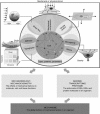Mechanomics: an emerging field between biology and biomechanics
- PMID: 24756566
- PMCID: PMC4085284
- DOI: 10.1007/s13238-014-0057-9
Mechanomics: an emerging field between biology and biomechanics
Abstract
Cells sense various in vivo mechanical stimuli, which initiate downstream signaling to mechanical forces. While a body of evidences is presented on the impact of limited mechanical regulators in past decades, the mechanisms how biomechanical responses globally affect cell function need to be addressed. Complexity and diversity of in vivo mechanical clues present distinct patterns of shear flow, tensile stretch, or mechanical compression with various parametric combination of its magnitude, duration, or frequency. Thus, it is required to understand, from the viewpoint of mechanobiology, what mechanical features of cells are, why mechanical properties are different among distinct cell types, and how forces are transduced to downstream biochemical signals. Meanwhile, those in vitro isolated mechanical stimuli are usually coupled together in vivo, suggesting that the different factors that are in effect individually could be canceled out or orchestrated with each other. Evidently, omics analysis, a powerful tool in the field of system biology, is advantageous to combine with mechanobiology and then to map the full-set of mechanically sensitive proteins and transcripts encoded by its genome. This new emerging field, namely mechanomics, makes it possible to elucidate the global responses under systematically-varied mechanical stimuli. This review discusses the current advances in the related fields of mechanomics and elaborates how cells sense external forces and activate the biological responses.
Figures


References
-
- Angele P, Schumann D, Angele M, Kinner B, Englert C, Hente R, Fuchtmeier B, Nerlich M, Neumann C, Kujat R. Cyclic, mechanical compression enhances chondrogenesis of mesenchymal progenitor cells in tissue engineering scaffolds. Biorheology. 2004;41:335–346. - PubMed
-
- Baba K, Asada T, Hayashi T. Relation between developmental changes on anatomical structure and on protein pattern in differentiating xylem of tension wood. J Wood Sci. 2000;46:1–7.
-
- Barakat AI, Lieu DK. Differential responsiveness of vascular endothelial cells to different types of fluid mechanical shear stress. Cell Biochem Biophys. 2003;38:323–343. - PubMed
Publication types
MeSH terms
Substances
LinkOut - more resources
Full Text Sources
Other Literature Sources
Miscellaneous

